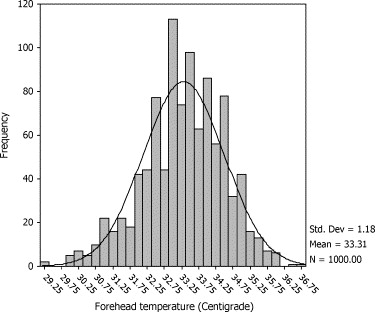
This website is for students following the M.Sc. in Evidence Based Practice at the University of York.
The following is the abstract of a paper:
Background: Noncontact forehead temperature measurement by handheld infrared thermometer was used as a screening tool for fever. However, the accuracy data and normal range of forehead temperature determined by this method were not available.
Methods: The temperature readings from 3 handheld infrared thermometers were validated against an electronic thermometer. Normal range of forehead temperature was determined by measuring the forehead temperature in 1000 apparently healthy subjects.
Results: Significant differences were detected in readings obtained by the 3 different handheld infrared thermometers (analysis of covariance, P < 0.001). The most accurate one was chosen, and the normal range of forehead temperature in 1000 subjects detected by this method was 31.0°C to 35.6°C.
Conclusions: Our study shows that commercially available, handheld infrared thermometers require individual validation. Forehead temperature in excess of 35.6°C is suggestive of fever. Further studies are required to confirm accuracy of this value in detecting fever.
(Source: Ng DK, Chan C, Chan EY, Kwok K, Chow P, Lau W, Ho JC. A brief report on the normal range of forehead temperature as determined by noncontact, handheld, infrared thermometer. American Journal of Infection Control 2005; 33: 227-229.)
The sample for the normal range was found as follows: 'Staff and visitors of our hospital were invited to join the study. Subjects aged over 18 years and below 65 years were enrolled in this study. Individuals with a history of fever, ingestion of antipyretic, and immunization within the preceding 7 days or those with symptoms such as cough, runny nose, or sore throat were excluded.'
The authors produced the following graph for forehead temperature (FT) in 1000 apparently healthy adults:

They wrote that 'The normal range for FT was 31.0°C to 35.6°C (87.8°F to 96.1°F) (mean ± 1.96° standard deviation). Those with FT higher than 35.6°C were statistically abnormal.'
Back to Measurement in Health and Disease index.
This page maintained by Martin Bland.
Last updated: 2 March, 2007.